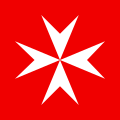Flag of Castilla-La Mancha
The flag of Castilla-La Mancha is one of the representative symbols of the autonomous community of Castilla-La Mancha, in Spain, and is defined by its Statute of Autonomy.
History
With the Region of Castilla-La Mancha already created under a pre-autonomy regime, and before the Statute of Autonomy is drawn up, the political parties present in the so-called pre-autonomous entity decide to adopt distinctive symbols for the community. The choice of the distinctive was the subject of studies and proposals. Seven reasoned projects were discussed at the meeting of the Board held in Albacete on January 11, 1980, and finally the one presented by Ramón José Maldonado y Cocat, La Mancha heraldist, corresponding academic of History, was chosen, to whose work much of the work is owed. of the municipal heraldic shields adopted in the second half of the XX century in the province of Ciudad Real. The proposal finally approved was the following:
RAMÓN JOSÉ MALDONADO COCAT, Académico correspondiente de las Reales de la Historia y de Bellas Artes de San Fernando, at the request of the political parties: Union de Centro Democrático, Alianza Popular y Partido Socialista Obrero Español, en beg that I study and determine, on a possible flag for the Manchega Region that collects in its colors, its historical origins and its character as Region, I have the honour to present the following report: In the piece of fabric attached to the asta, the shield or Pendon of Castile, an ancient Kingdom to which all this land belonged and which is: in the red countryside the castle of three golden towers made of black and cleared of blue. The second piece of white colour, in remembrance of the Military Orders of Calatrava, Santiago and San Juan, whose glorious militias conquered, organized and administered the Manchega land and whose pendules were always white and white the Cross of San Juan, on red; the cities, villas and places that came from Señorío Real, are represented in the first barracks of the flag. - It is what the Academician who subscribes to, can represent the historical origin of our land and be adopted as the Banner of the Taint.In Ciudad Real, 15 December 1977
The corresponding decree approving the flag was published in number 1 of the Official Gazette of the Community Board, dated October 20, 1980.
Current regulation

The Organic Law 9/1982, of August 10, of the Statute of Autonomy of Castilla-La Mancha (BOE August 16, 1982), consecrates the flag designed by Maldonado, providing in its fifth article:
- The flag of the region is composed of a rectangle divided vertically into two equal squares: the first, next to the mast, of a crimson red colour with a sable-painted gold castle and cleared of blue and the second, white.
- The flag of the region will wave in the public buildings of regional, provincial or municipal ownership, and will appear next to the flag of Spain, which will have a preeminent place; also the representative of the historical territories may appear.
- The Castilla-La Mancha Region will have its own shield and hymn. A Law of Cortes de Castilla-La Mancha will determine the shield and the anthem of the region.
- The provinces, districts and municipalities of the region will retain their traditional flags, shields and emblems.
On the other hand, the draft Law to reform the Statute of autonomy of Castilla-La Mancha, which is being processed in the Congress of Deputies, transfers the regulation of regional symbols to article 4 and incorporates slight modifications in the text:[citation required]
Article 4. Symbols and official party.
- The flag of the Autonomous Community is composed of a rectangle divided vertically into two equal squares: the first, next to the mast, of a carmesi red colour with a sable-painted gold castle and lightening of azur and the second white.
The flag of Castilla-La Mancha will wave in the public buildings of regional, provincial or municipal ownership and will appear next to the flag of Spain, which will take place preeminent. Similarly, the representative of the historical territories may appear. Next to the flags of Spain and Castilla-La Mancha will be the flag of the European Union.- The Community of Castilla-La Mancha will have its own shield and hymn in the terms established by law.
- The day of Castilla La-Mancha is celebrated on May 31.
- The provinces, municipalities and regions of the Autonomous Community will retain their traditional flags, shields and emblems.
Currently there is no legal regulation in force on the official flag model, nor on the exact colors or the model of the castle, which is why frequent confusion occurs in this regard. All of this added to the fact that while the Statute of Autonomy speaks of "two equal squares", which implies that the proportions of the flag should be 1:2, while the flags used by the Community Board itself are of 2 proportions: 3, the same as the flag of Spain.
This variation in the proportions of the flag is due to the fact that Law 39/1981, which regulates the use of the flag of Spain and other flags and banners, in its article 6.2, establishes that when use the Spanish flag together with other flags, these cannot be larger. This is why the community flags that are commonly used have proportions adapted to match the size of the Spanish flag.
Curiosities
- The first Manchegos autonomist movements, created in the early centuryXX. and that were circumscribed to Ciudad Real and part of the provinces of Toledo, Cuenca and Albacete, they used a very different flag, which, although not much use, was known as the flag of La Mancha. The design of this flag originates in the herald of the Manchega provinces: black by Toledo, red by Cuenca, blue by Ciudad Real and white by Albacete.
- Castilian movements on their part have always considered the Carmelite pendulum of Castile.
- One circumstance to review is that because of the incorrect description of the flag contained in the Statute (in the current and in which it comes) and subsequent provisions ('two equal squares'), it is assumed that the official proportions of the flag are 1:2, contravening the general rule in the Spanish flags and in most European countries that these are 2:3. By the way of fact, this situation has been corrected, making and using the flags in the most common proportions (2:3), instead of those established by the Statute, and with a design of the castle different from that contained in the official model of shield.
- Another curiosity to review is that, contrary to what usually happens, the Castile-La Mancha shield has its origin in the design of the flag and not the reverse.
Historical flags
Historic Pendon of Castile in Charmesi background
Pendon of Castilla la Nueva and its precursor, the kingdom of Toledo
Cross of the Order of Calatrava
Cross of the Order of Santiago
Cross of the Order of Saint John
1906 Flag Proposal
1919 Flag Proposal of La Mancha






